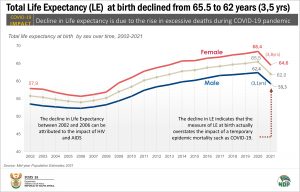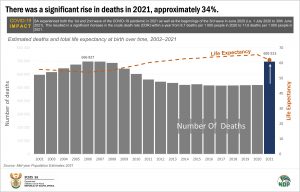COVID-19 epidemic reduces life expectancy in 2021
The population of South Africa was estimated to be 60,14 million at mid-year 2021, an increase of about 604 281 (1,01%) since mid-year 2020. The latest Mid-year population estimates, 2021 released by Statistics South Africa (Stats SA), shows that the COVID-19 pandemic impacted mortality and migration in the country since the start of the pandemic early in 2020.
South Africa experienced both peaks of deaths in the first and second waves of the COVID-19 pandemic within the 2021 Mid-year Population Estimates (MYPE) period between July 2020 and June 2021. This resulted in a significant increase in the crude death rate (CDR) from 8,7 deaths per 1 000 people in 2020 to 11,6 deaths per 1 000 people in 2021. The significant rise in deaths in 2021 (approximately 34%), meant a drop in the 2021 Life expectancy (LE) at birth for South Africa.
Life expectancy at birth for males declined from 62,4 in 2020 to 59,3 in 2021 (3,1 year drop) and from 68,4 in 2020 to 64,6 for females (3,8 year drop). Whilst the Life expectancy at birth indicator is an important health indicator, in this COVID-19 period it should not be interpreted as a projection of an individual’s lifespan, but should rather be used to shed light on the cumulative burden of a crisis compared to recent trends.
To make informed decisions for planning purposes when experiencing transitory mortality shocks such as the COVID-19 pandemic, the use of a combination of mortality measures, i.e. crude death rate and age specific mortality over time, should be used. Assuming greater vaccination coverage, continued prevention practices i.e. mask wearing; social distancing and sanitising of hands and surfaces; further innovation in drug and treatment protocols; and the avoidance of more severe or infectious strains of the virus leading to future waves, may likely see life expectancy in South Africa revert to previous levels.
Internationally, “excess deaths” – defined as deaths observed during the COVID-19 pandemic above a baseline of recent trends – substantially increased mortality in 2020 and 2021. Deaths arising from constraints on, or overburdening of, the health care system due to the COVID-19 pandemic are often unaccounted for in the impact of COVID-19, but are imperative in estimating mortality occurring in the country.
Between 1st July 2020 and 30th June 2021, two waves of the pandemic swept across the country and, by the 11th June 2021, the National Institute for Communicable Diseases (NICD) reported that the country had technically entered a third wave. The second wave was driven by the beta variant of the COVID-19 virus while the third wave is driven by the delta variant, the most contagious version of the coronavirus to date. These waves resulted in significantly higher proportions of deaths in the country than would normally have occurred. As a result of this rise in deaths, life expectancy at birth declined significantly.
During the early days of the epidemic, estimated COVID-19 deaths were hampered by definitional inconsistencies, logistical issues and general aspects that come with attempting to count whilst also researching a relatively unknown epidemic with unclear testing, monitoring and classification processes at the time. The age-mortality profile of the disease indicates that older people and those with co-morbidities, specifically diabetes and hypertension, face a higher risk of mortality. Broader categories of respiratory diseases, circulatory diseases, cancer and HIV and AIDS also face higher risk of mortality.
What is certain is that the COVID-19 pandemic has changed the very core of how we interact in society and what we once knew as normal. As new data becomes available over time, we will have a better sense of the full impact of the pandemic on the demography of the nation and the world.
For more information, download the full report here.




